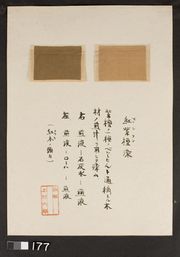Difference between revisions of "Redwood dye"
Jump to navigation
Jump to search
m (Text replace - "\[http:\/\/cameo\.mfa\.org\/materials\/fullrecord\.asp\?name=([^\s]+)\s(.*)\]" to "$2") |
|||
| (5 intermediate revisions by the same user not shown) | |||
| Line 1: | Line 1: | ||
| + | [[File:Uemura_07-09-2009_177.jpg|thumb|Redwood dye on silk<br>Uemera Dye Archive]] | ||
| + | |||
== Description == | == Description == | ||
| Line 4: | Line 6: | ||
2) An insoluble red dye from many varieties of trees, such as camwood (''Baphia nitida'' - West Coast of Africa), barwood (''Baphia nitida'' Lodd., Sierra Leone), narrawood (Philippines), caliatour wood (East Indies) and sandalwood (''Pterocarpus santalinus'', tropical Asia) can all be classified as insoluble Redwoods. They all contain santalin. Though they resemble Brazilwood, their dyes are much more stable and difficult to prepare. See [[sandalwood%20dye|sandalwood dye]]. | 2) An insoluble red dye from many varieties of trees, such as camwood (''Baphia nitida'' - West Coast of Africa), barwood (''Baphia nitida'' Lodd., Sierra Leone), narrawood (Philippines), caliatour wood (East Indies) and sandalwood (''Pterocarpus santalinus'', tropical Asia) can all be classified as insoluble Redwoods. They all contain santalin. Though they resemble Brazilwood, their dyes are much more stable and difficult to prepare. See [[sandalwood%20dye|sandalwood dye]]. | ||
| + | |||
| + | * See also [[https://cameo.mfa.org/wiki/Category:Uemura_dye_archive '''Uemera Dye Archive''' (Benishitan)]] | ||
== Synonyms and Related Terms == | == Synonyms and Related Terms == | ||
| Line 9: | Line 13: | ||
colorante de madera roja (Esp.); colorant à base de bois rouge (Fr.); sandalwood; camwood; barwood; caliaturwood; narrawood; sanderswood | colorante de madera roja (Esp.); colorant à base de bois rouge (Fr.); sandalwood; camwood; barwood; caliaturwood; narrawood; sanderswood | ||
| − | == | + | ==Resources and Citations== |
| − | J.Hofenk-de Graaf, ''Natural Dyestuffs: Origin, Chemical Constitution, Identification'', Central Research Laboratory for Objects of Art and Science, Amsterdam, September 1969. | + | * J.Hofenk-de Graaf, ''Natural Dyestuffs: Origin, Chemical Constitution, Identification'', Central Research Laboratory for Objects of Art and Science, Amsterdam, September 1969. |
* Analytical strategies for natural dyestuffs in cultural heritage objects - EU-ARTECH European research project - http://www.organic-colorants.org | * Analytical strategies for natural dyestuffs in cultural heritage objects - EU-ARTECH European research project - http://www.organic-colorants.org | ||
| − | |||
| − | |||
* R.J. Adrosko, ''Natural Dyes in the United States'', Smithsonian Institution Press, Washington, DC, 1968 | * R.J. Adrosko, ''Natural Dyes in the United States'', Smithsonian Institution Press, Washington, DC, 1968 | ||
Latest revision as of 12:59, 22 June 2022
Description
1) A soluble red dye obtained brazilwood.
2) An insoluble red dye from many varieties of trees, such as camwood (Baphia nitida - West Coast of Africa), barwood (Baphia nitida Lodd., Sierra Leone), narrawood (Philippines), caliatour wood (East Indies) and sandalwood (Pterocarpus santalinus, tropical Asia) can all be classified as insoluble Redwoods. They all contain santalin. Though they resemble Brazilwood, their dyes are much more stable and difficult to prepare. See Sandalwood dye.
- See also [Uemera Dye Archive (Benishitan)]
Synonyms and Related Terms
colorante de madera roja (Esp.); colorant à base de bois rouge (Fr.); sandalwood; camwood; barwood; caliaturwood; narrawood; sanderswood
Resources and Citations
- J.Hofenk-de Graaf, Natural Dyestuffs: Origin, Chemical Constitution, Identification, Central Research Laboratory for Objects of Art and Science, Amsterdam, September 1969.
- Analytical strategies for natural dyestuffs in cultural heritage objects - EU-ARTECH European research project - http://www.organic-colorants.org
- R.J. Adrosko, Natural Dyes in the United States, Smithsonian Institution Press, Washington, DC, 1968
- S. Grierson, The Colour Cauldron, Oliver McPherson Ltd., 1986
- G.S.Brady, Materials Handbook, McGraw-Hill Book Co., New York, 1971 Comment: p. 657
- F. Crace-Calvert, Dyeing and Calico Printing, Palmer & Howe, London, 1876
